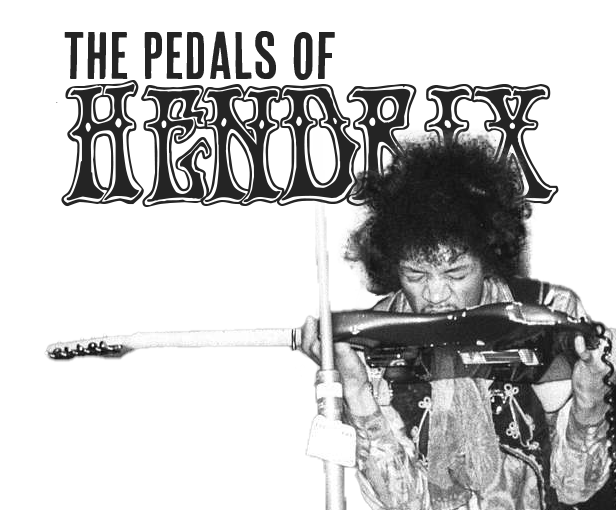
Up from the skies, seemingly from outer space, Jimi Hendrix exploded the music scene of the late 1960s. Never has a guitarist/singer/alien had such a meteoric effect on popular culture that still resonates even 55 years later. His profound impact on music was instant. The body of work recorded in just three years is bulletproof.
A true sonic pioneer, Hendrix was fearless in embracing the latest advancements in musical technology. His mastery of the guitar extended beyond his fingers down to the effects at his feet. For us guitar players, the tools employed by Hendrix have become as iconic as the music created using them. Fender Stratocaster (coiled cable), Vox Wah, Roger Mayer Octavia, Dallas Arbiter Fuzz Face, Shin-Ei/Honey Uni-Vibe, into a plethora of screaming 100-watt Marshall full-stack amps.
I’d be remiss if I didn’t note that Hendrix experimented extensively with different guitars, amps, pedal order/modifications, etc. In this series, we’re looking at the ubiquitous effects of Hendrix: the effect still felt today by his masterful implementation and the genius involved in creating these timeless effects.
Part I: The Vox Wah Pedal

A Brief History
“I went next door and asked a friend of mine to plug a guitar into this pile of wires, resistors, and capacitors I had on the bench. He strummed a few chords while I turned the knob on the potentiometer. It went ‘WAH-WAH-WAH.’ We looked at each other and said, ‘Wow! This is really great!’” - Brad Plunkett
February 9, 1964, 73 million Americans tuned into The Ed Sullivan Show to experience the Beatles. In one fell swoop, the Beatles captured the United States and simultaneously introduced Vox amps to Americans. Vox was catapulted from a small amp shop in England to international fame. This eventually led to Vox (Jennings Musical Industries or JMI) selling the North American trademark rights to Thomas Organ Company in Sepulveda, California. After the acquisition, Thomas Organ believed that the future of Vox amps was transistor-based, solid-state amplification.
This trajectory led to the invention of the Mid-Range Resonant Boost (MRB). The MRB was a three-position switch placed in the preamp section of the new solid-state amplifiers and offered a selectable mid-range boost at 500hz, 700hz, or 1000hz. Head engineer at Thomas Organ, Stan Cutler, wrote a letter to Tom Jennings (then president of JMI Vox) describing the new MRB circuit.
Cutler wrote, “The [mid-range] resonant boost feature may represent a new sound in guitar amplifiers and can be carried to any degree of variety by providing multiple switch positions in which different effects may be obtained… An interesting wah-wah effect is obtained by operating the boost switch between the two positions. A remote control for this on the guitar would be novel. However, the cost and complication would probably be high."
After the invention of the MRB, Vox engineer Brad Plunkett was tasked to redesign the circuit to lower production costs. The price of three-position switches versus the much lower price of a rotary potentiometer was the driving force of the decision to redesign the circuit. The rotary potentiometer also added the benefit of sweeping through the mid-frequencies instead of being bound by the predetermined values of the rotary.
While testing the redesigned MRB, guitarist and Vox demo artist, Del Casher heard the unique sounds coming from Brad Plunkett’s tests and was moved enough to reach out to Stan Cutler about this new flavor of tone. In an interview with Josh Scott of JHS Pedals, Del said, “I definitely remember going to Stanley Cutler, head of engineering, and [saying], ‘Stan, I know that this can be lifted out of the amplifier. So, can you get me the guy who did that?’ He said, ‘Well, it was Brad Plunkett.’ So I said, ‘Tell Brad that I want the breadboard put into a pedal.’ So they had the breadboard put into a pedal at my request.”
The newly redesigned MRB circuit was then placed into a Vox Continental Organ volume pedal, and in 1966 the first Wah pedal was born. Seeing the massive potential, Casher took the pedal to Joe Benaron, president of Thomas Organ. Benaron, a fan of big-band music, saw the new device as a way for trumpeters to imitate the sound of a rubber mute without physically manipulating the horn. As the guitar was not as widely adopted in 1966 as it is today, marketing the pedal to horn players was a safer bet.
In an interview, Casher says, “I remember my brother had a recording of a guy named Clyde McCoy who played the trumpet in the [song] “Sugar Blues.” I said, ‘Why don't you call it [the] McCoy?’ jokingly. I figured Clyde McCoy was dead. He wasn't. He was still alive.”
In 1967, Clyde McCoy agreed to let Thomas Organ use his name and picture on their Wah pedal for $500 ($4,433.70 today). Not long after the initial production of the “Vox Clyde McCoy Wah-Wah Pedal,” Thomas Organ changed the name to the “Vox V846 Wah-Wah.” As Vox Wah pedals gained popularity, competing Wah pedals began cropping up.
Realizing the limiting nature of only being able to sell Vox Wah pedals to Vox Authorized dealers, Thomas Organ began rebranding the Clyde McCoy wah and the V846 as the “Cry Baby” and the “King Vox Wah” to expand their market reach and make it more difficult for competitors to enter the space. Thomas Organ later shared the schematic with JMI in the United Kingdom, allowing them to begin production of the “Vox Wah-Wah Pedal” in 1967.
Jimi and the Wah

The story of how the Vox Wah pedal ended up in Hendrix’s hands (or feet) is somewhat shrouded in rock ’n roll mystery. There are two prevailing theories:
Theory #1:
Del Casher befriends a young, eclectic musician named Frank Zappa. Through their friendship, Zappa acquires a Vox Wah Pedal and begins using it on the road. In July of 1967, Hendrix caught a Frank Zappa and the Mothers of Invention show in New York City, where he first saw the Wah pedal. Zappa proceeds to give Hendrix a Wah pedal, and in August of ’67, Hendrix is photographed using it.
Theory #2:
Jimi Hendrix Experience bass player Noel Redding is gear shopping in London when he gets recognized by one of the shop employees. The employee tells him to bring Hendrix by so he can try out this new pedal they have in stock. Jimi tries it out, and the rest is history.
Regardless of how he ended up with it, Hendrix integrated the Wah almost instantly into his sonic arsenal, becoming a staple of his sound from that point forward. Hendrix is credited with having some of the earliest known commercial recordings using the Wah pedal. Songs such as “Up From the Skies,” “Little Miss Lover,” and “Burning the Midnight Lamp” (all recorded in 1967) all prominently highlight the pedal that didn’t exist a year prior. The sonic experimentation came to a head in 1968 when the final track for the Electric Ladyland album was recorded. “Voodoo Child (Slight Return)” is one of those songs so heavily defined by the Wah-Wah intro that it is impossible to hear without it.
Nearly impossible to replicate, it’s as if the Wah is no longer a pedal, but it is the instrument. This magnum opus of psychedelia meets rock n’ roll proves one of the most timeless of the Hendrixian catalog. Through his virtuosic ability and fearless approach to sonic exploration, the Wah-Wah pedal has been cemented into the toolbox of guitar players.
Wah-Wah and the Modern Pedal Market
It’s no secret that we live in the golden age of effects pedals. Today’s gear market is divided into three branches: (1) mass-produced, (2) boutique/niche, and (3) vintage/out-of-production. The options are endless, and with Wah, it’s no different.
In 1981, Jim Dunlop bought the “Cry Baby” brand from Thomas Organ, and since then, Dunlop has been the largest producer of Wah pedals worldwide. With over 30 models in their lineup, Dunlop offers signature models from Hendrix to Hammett. Vox and Morley are also significant producers in the mass-produced sector as well. Wah pedals in this market can be bought for ~$50-$200. The boutique/niche sector pays close attention to the original designs and, in some cases, uses NOS (new old stock) components to build these units. RMC, Xotic, and JAM Pedals are a few companies occupying this market space, with prices ranging from ~$250-$500. The vintage/out-of-production area is the most volatile space. With pricing from ~$100-$2500+, everything from collector’s items to hidden gems lives here.
As with any market, the laws of supply and demand are king. Wah pedals with the Hendrix inspiration and branding are still being produced and sold 52 years after his death. It’s hard to speculate whether the Wah pedal would be as widely accepted and marketed were it not for Hendrix. Eddie Van Halen, Steve Vai, Stevie Ray Vaughan, Slash, and many other guitar heroes are all progenitors of the Wah, whose Wah-styling is Hendrixian by nature. The multi-faceted impact that Hendrix continues to have on the market and music is undeniable.

